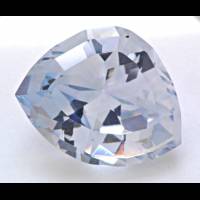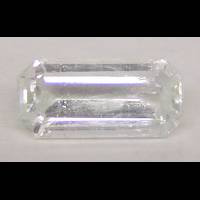Celestine

Madagascar
20.50 carats
© Rarestone.com
Celestine is usually colourless or pale blue, but orange (Ontario, Canada), brown, yellow and greenish material has been reported.
It occurs as tabular and prismatic crystals, and also in compact massive and fibrous forms or as numerous crystals lining geodes. The geode has crystals as 18 inches wide (46 cm) across, estimated weight up to 300 pounds (135 kg) each.
Perfect cleavage and brittleness make Celestine difficult to facet. Cut stones rarely exceed 10 carats.
Celestine Gemstones by Colour
This table shows the variety of hues this gemstone can be found in. Click on a photo for more information.
Celestine Gemstones by Size
This table shows distribution of Celestine gemstone sizes that are listed on this site. This can give a good indication as to the general availability of this gemstone in different sizes.
Contributed photos
Lightest:4.55 cts
Heaviest:20.50 cts
Average:12.53 cts
Total photos:2
Do you have a larger Celestine? Why not upload a photo?
| General Information | |||||||
|---|---|---|---|---|---|---|---|
| Other Names/Trade Names: | |||||||
| Chemical Formula |
| ||||||
| Celestine Treatments | |||||||
| Celestite, SrSO4, also called celestine, as well as the closely related ,materials anhydrite, CaSO4, also called vulpinite (Webster, p. 298), and barite, BaSO4, are soft sulfates which occur at times with attractive violet or blue colors. Heating to as little as 200°C causes these colors to fade, as also sometimes happens on exposure to light. Irradiation restores or produces the blue or violet color, sometimes in a banded form; the color may be stable to light or may fade, depending on the nature of the material (Przibram and Caffyn, 1956; Pough, 1957). In celestite there are several color centers involved, including SO-3, SO-2 and O-, all stabilized by a potassium impurity (Bernstein, 1979) – Nassau (1984) | |||||||
| Physical Properties of Celestine | |||||||
| Mohs Hardness | 3 to 3.5, Blue Chart Gem Identification (2010) More from other references | ||||||
| Specific Gravity | 3.90 to 4.00, Blue Chart Gem Identification (2010) More from other references | ||||||
| Tenacity | Brittle, Blue Chart Gem Identification (2010) Very brittle | ||||||
| Cleavage Quality | Perfect, Gemstones (2009) | ||||||
| Fracture | Uneven, Gemstones (2009) | ||||||
| Heat Sensitivity | Sensitive to heat, Blue Chart Gem Identification (2010) | ||||||
| Optical Properties of Celestine | |||||||
| Refractive Index | 1.619 to 1.635, Blue Chart Gem Identification (2010) More from other references | ||||||
| Optical Character | Biaxial/+, Blue Chart Gem Identification (2010) More from other references | ||||||
| Birefringence | 0.004 to 0.012, Blue Chart Gem Identification (2010) More from other references | ||||||
| Pleochroism | Weakly trichroic, Gemstones (2009) | ||||||
| Dispersion | Nil, Gemstones (2009) | ||||||
| Colour | |||||||
| Colour (General) | Bluish-white, colourless, seldom reddish, green, Gemstones of the world (2001) More from other references | ||||||
| Transparency | Transparent, Gems, Sixth Edition (2006) More from other references | ||||||
| Lustre | Vitreous, Gemstones of the world (2001) More from other references | ||||||
| Fluorescence & other light emissions | |||||||
| Fluorescence (General) | Inert to weak fluorescence of body color (possible phosphorescence), Blue Chart Gem Identification (2010) More from other references | ||||||
| Crystallography of Celestine | |||||||
| Crystal System | Orthorhombic, Blue Chart Gem Identification (2010) More from other references | ||||||
| Habit | Tabular, Gems, Sixth Edition (2006) More from other references | ||||||
| Geological Environment | |||||||
| Where found: | The origin of celestine is chiefly sedimentary. It occurs as cavity or fissure fillings, particularly in limestones and in hydrothermal veins., Gems, Sixth Edition (2006) | ||||||
| Inclusions in Celestine | |||||||
| Liquid inclusions, partially healed fractures - Blue Chart Gem Identification, Herve Nicolas Lazzarelli, 2010, p 5 | |||||||
| Further Information | |||||||
| Mineral information: | Celestine information at mindat.org | ||||||
| Significant Gem Localities | |||||||
| |||||||

